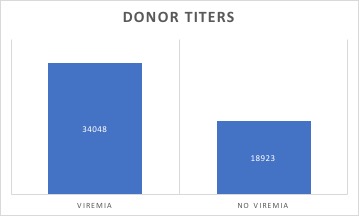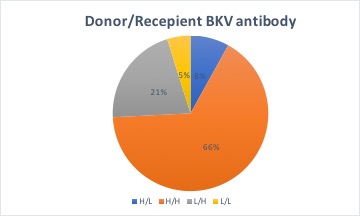The Utility of Donor and Recipient BK Virus Antibody Testing Prior to Renal Transplantation in Risk Assessment for Developing BK Viremia
Driscoll Children's Hospital, Corpus Christi, TX
Meeting: 2019 American Transplant Congress
Abstract number: C223
Keywords: Infection, Kidney, Pediatric, Polyma virus
Session Information
Session Name: Poster Session C: Kidney: Pediatrics
Session Type: Poster Session
Date: Monday, June 3, 2019
Session Time: 6:00pm-7:00pm
 Presentation Time: 6:00pm-7:00pm
Presentation Time: 6:00pm-7:00pm
Location: Hall C & D
*Purpose: The correlation between donor (DON) and recipient (REC) BKV antibody (AB) titers and BK viremia in renal transplant (RTx) has not been well-studied in pediatric (PED) patients. The study objective was to assess whether testing for DON/REC BKV AB prior to RTx is beneficial for risk assessment of BK viremia in PED RTx REC.
*Methods: This is a single-center, retrospective study of 66 PED RTx REC transplanted between 2010 to 2018. DON and REC BKV AB were tested at the time of Tx. We classified AB status based on titer into: low (≤2560) and high (>2560). RTx REC were tested routinely for BK viriuria monthly, starting at one month after Tx. Testing for BK viremia was initiated once BK viriuria was detected, and repeated until viremia became undetectable.
*Results: Mean REC age was 11.9 ± 5.9. There were 50 (76%) primary Tx and 16 (24%) re-Tx. Overall, 88% of REC and 76% of DON had BKV AB titers > 2560. Among REC, 57% had BK AB titer > 10240 (48.8% of REC > 12 years of age vs 28.6% of REC < 12 years of age, p < 0.05), while among DON, only 32% had BK AB titer > 10240. BK viriuria was detected in 24 REC (36%), while BK viremia was detected in 10 REC (15%), none of them developed BKV nephropathy. The mean time to first detection of BKV viriuria and viremia after Tx was 93 and 116 days, respectively. Mean DON titer in RTx REC with viremia was 34048 vs. 18923 in those without viremia (p 0.06). Mean REC AB titer was 51200 in RTx REC with viremia vs. 30118 in those without viremia (p = NS). High DON titers were correlated with less days to detection of BK viriuria (p 0.02). BK viremia incidence was highest in the DON/REC high/high status, with 8 of 9 viremia patients (89%). We did not find any correlation between DON, REC, or DON/REC AB status and incidence of BK viremia.
*Conclusions: Our BK viremia rate was low overall. We did not have any case of BKV nephropathy. We did not find any significant correlation between DON and REC BKV AB titers and BK viremia incidence. The high prevalence of high recipient BKV AB titer in our cohort (88% with BKV titer > 2560) was an unexpected finding, and may indicate a high rate of early exposure to BKV infection in our patients. Testing DON and REC AB status was not helpful in our cohort. Active screening for BKV infection after Tx remains the best strategy to detect BK viremia.
To cite this abstract in AMA style:
Donmez N, Al-Akash SI. The Utility of Donor and Recipient BK Virus Antibody Testing Prior to Renal Transplantation in Risk Assessment for Developing BK Viremia [abstract]. Am J Transplant. 2019; 19 (suppl 3). https://atcmeetingabstracts.com/abstract/the-utility-of-donor-and-recipient-bk-virus-antibody-testing-prior-to-renal-transplantation-in-risk-assessment-for-developing-bk-viremia/. Accessed December 25, 2025.« Back to 2019 American Transplant Congress


